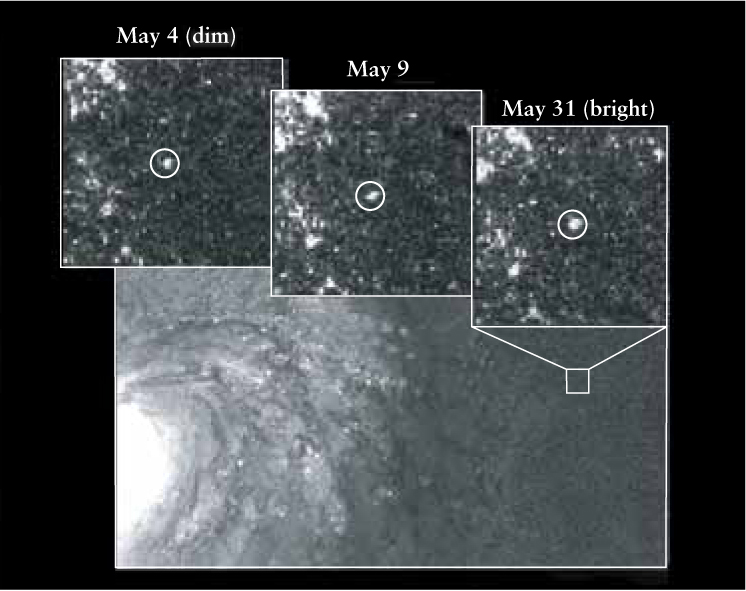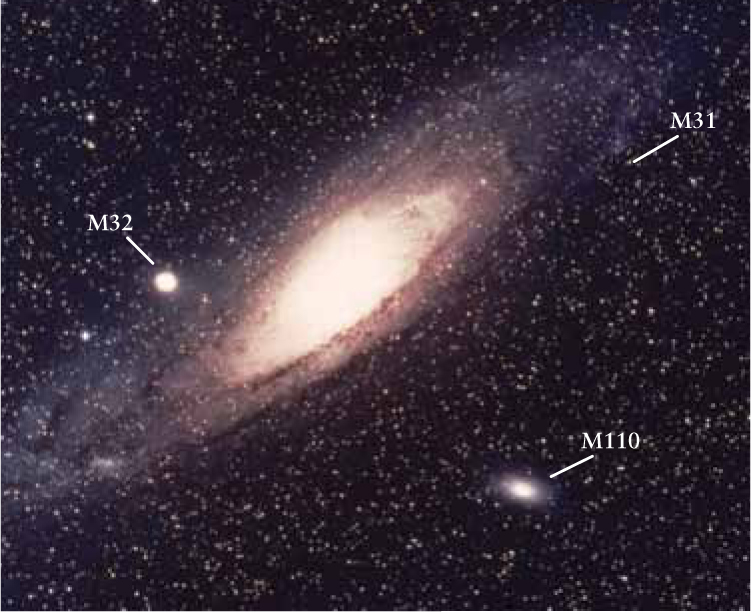23-2 Hubble proved that the spiral nebulae are far beyond the Milky Way
After completing his studies, Edwin Hubble joined the staff of the Mount Wilson Observatory in Pasadena, California. On October 6, 1923, he took an historic photograph of the Andromeda “Nebula,” one of the spiral nebulae around which controversy raged. (Figure 23-3 is a modern photograph of this object.)

 R I V U X G
R I V U X GMeasuring Galaxy Distances with Cepheid Variables By observing Cepheid variable stars in M100, the galaxy shown here, astronomers have found that it is about 17 Mpc (56 million ly) from Earth. The insets show one of the Cepheids in M100 at different stages in its brightness cycle, which lasts several weeks.

The Andromeda Galaxy Also known as M31, the Andromeda Galaxy can be seen with a small telescope, or even the naked eye on a clear night. Edwin Hubble was the first to demonstrate that M31 is actually a galaxy that lies far beyond the Milky Way. M31 is the largest galactic neighbor near our Milky Way. A collision between our Milky Way and the Andromeda Galaxy is expected in about 3.75 billion years. M32 and M110 are two small satellite galaxies that orbit M31.
Just as RR Lyrae variable stars demonstrated the extent of the Milky Way, Cepheid variables revealed the immense distances to other galaxies
Hubble carefully examined his photographic plate and discovered a new bright spot—what he at first thought to be a nova. Referring to previous plates of that region, he soon realized that the object was actually a Cepheid variable star. Further scrutiny of additional plates over the next several months revealed several more Cepheids. Figure 23-4 shows modern observations of a Cepheid in another “spiral nebula.”
As we saw in Section 19-6, Cepheid variables help astronomers determine distances. An astronomer begins by carefully measuring the variations in apparent brightness of a Cepheid variable, then recording the results in the form of a plot of brightness versus time, or light curve (see Figure 19-18a). This graph gives the variable star’s period and average brightness. Given the star’s period, the astronomer then uses the period-luminosity relation shown in Figure 19-20 to find the Cepheid’s average luminosity. Knowing both the apparent brightness and luminosity of the Cepheid, the astronomer can then use the inverse-square law to calculate the distance to the star (see Box 17-2). Box 23-1 presents an example of this calculation. This procedure is very similar to that used by Harlow Shapley to measure the distances to the Milky Way’s globular clusters using RR Lyrae variable stars (see Section 22-1).
670
TOOLS OF THE ASTRONOMER’S TRADE
Cepheids and Supernovae as Indicators of Distance
Because their periods are directly linked to their luminosities, Cepheid variables are one of the most reliable tools astronomers have for determining the distances to galaxies. To this day, astronomers use this link—much as Hubble did back in the 1920s—to measure intergalactic distances. More recently, they have begun to use Type Ia supernovae, which are far more luminous and thus can be seen much farther away, to determine the distances to very remote galaxies.
EXAMPLE: In 1992 a team of astronomers observed Cepheid variables in a galaxy called IC 4182 to deduce this galaxy’s distance from Earth. One such Cepheid has a period of 42.0 days and an average apparent magnitude (m) of +22.0. (See Box 17-3 for an explanation of the apparent magnitude scale.) By comparison, the dimmest star you can see with the naked eye has m = +6; this Cepheid in IC 4182 appears less than one one-millionth as bright.
According to the period-luminosity relation shown in Figure 19-20, such a Cepheid with a period of 42.0 days has an average luminosity of 33,000 L⊙. An equivalent statement is that this Cepheid has an average absolute magnitude (M) of −6.5. (This compares to M = +4.8 for the Sun.) Use this information to determine the distance to IC 4182.
Situation: We are given the apparent magnitude m = +22.0 and the absolute magnitude M = −6.5 of the Cepheid variable star in IC 4182. Our goal is to calculate the distance to this star, and hence the distance to the galaxy of which it is part.
Tools: We use the relationship between apparent magnitude, absolute magnitude, and distance given in Box 17-3.
Answer: In Box 17-3, we saw that the apparent magnitude of a star is related to its absolute magnitude and distance in parsecs (d) by
m − M = 5 log d − 5
This equation can be rewritten as
We have m − M = (+22.0) − (−6.5) = 22.0 + 6.5 = 28.5. (Recall from Box 17-3 that m − M is called the distance modulus.) Hence, our equation becomes
d = 10(28.5 + 5)/5 parsecs = 106.7 parsecs = 5 × 106 parsecs
(A calculator is needed to calculate the quantity 106.7.)
Review: Our result tells us that the galaxy is 5 million parcsecs, or 5 Mpc, from Earth (1 Mpc = 106 pc). This distance can also be expressed as 16 million light-years.
EXAMPLE: Astronomers are interested in IC 4182 because a Type Ia supernova was observed there in 1937. All Type Ia supernovae are exploding white dwarfs that reach nearly the same maximum brightness at the peak of their outburst (see Section 20-9). Once astronomers know the peak absolute magnitude of Type Ia supernovae, they can use these supernovae as distance indicators. Because the distance to IC 4182 is known from its Cepheids, the 1937 observations of the supernova in that galaxy help us calibrate Type Ia supernovae as distance indicators.
At maximum brightness, the 1937 supernova reached an apparent magnitude of m = +8.6. What was its absolute magnitude at maximum brightness?
Situation: We are given the supernova’s apparent magnitude m, and we know its distance from the previous example. Our goal is to calculate its absolute magnitude M.
Tools: We again use the relationship m − M = 5 log d − 5.
Answer: We could plug in the value of d found in the previous example. But it is simpler to note that the distance modulus m − M has the same value no matter whether it refers to a Cepheid, a supernova, or any other object, just so it is at the same distance d. From the Cepheid example we have m − M = 28.5 for IC 4182, so
M = m − (m − M) = 8.6 − (28.5) = −19.9
This absolute magnitude corresponds to a remarkable peak luminosity of 1010 L⊙.
Review: Whenever astronomers find a Type Ia supernova in a remote galaxy, they can combine this absolute magnitude with the observed maximum apparent magnitude to get the galaxy’s distance modulus, from which the galaxy’s distance can be easily calculated (just as we did above for the Cepheids in IC 4182). This technique has been used to determine the distances to galaxies hundreds of millions of parsecs away (see Section 25-4).
671
Cepheid variables are intrinsically quite luminous, with average luminosities that can exceed 104 L⊙. Hubble realized that for these luminous stars to appear as dim as they were on his photographs of the Andromeda “Nebula,” they must be extremely far away. Straightforward calculations using modern data reveal that M31 is some 750 kiloparsecs (2.5 million light-years) from Earth. Based on its angular size, M31 has a diameter of 70 kiloparsecs—larger than the diameter of our own Milky Way Galaxy!
These results prove that the Andromeda “Nebula” is actually an enormous stellar system, far beyond the confines of the Milky Way. Today, this system is properly called the Andromeda Galaxy. (Under good observing conditions, you can actually see this galaxy’s central bulge with the naked eye. If you could see the entire Andromeda Galaxy, it would cover an area of the sky roughly 5 times as large as the full moon.) Galaxies are so far away that their distances from us are usually given in millions of parsecs, or megaparsecs (Mpc): 1 Mpc = 106 pc. For example, the distance to the galaxies in the image that opens this chapter is 17 Mpc.
Hubble’s results, which were presented at a meeting of the American Astronomical Society on December 30, 1924, settled the Shapley-Curtis “debate” once and for all. The universe was recognized to be far larger and populated with far bigger objects than anyone had seriously imagined. Hubble had discovered the realm of the galaxies.
CAUTION!
In everyday language, many people use the words “galaxy” and “universe” interchangeably. It is true that before Hubble’s discoveries our Milky Way Galaxy was thought to constitute essentially the entire universe. But we now know that the universe contains literally billions of galaxies. A single galaxy, vast though it may be, is just a tiny part of the entire observable universe.
CONCEPT CHECK 23-2
If a nearby galaxy were discovered, why would astronomers immediately look for Cepheids?